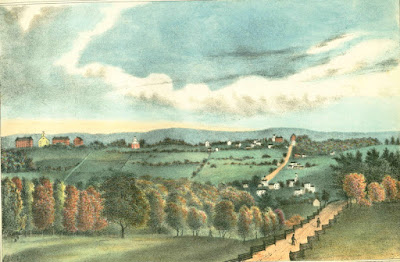 |
| Lithograph: Autumnal scenery, view in Amherst (1833), Courtesy of Jones Library Special Collections |
New Englanders have always been proud of the spectacular beauty of our local forests. “Europeans coming to America are surprised by the brilliancy of our autumnal foliage. There is no account of such a phenomenon in English poetry, because the trees acquire but few bright colors there,” Thoreau wrote for an essay in the Atlantic in 1862. He continues, “October is the month of painted leaves. Their rich glow now flashes round the world. As fruits and leaves and the day itself acquire a bright tint just before they fall, so the year near its setting. October is its sunset sky; November the later twilight.”
The specific phrase “leaf-peeper” appears to have evolved from “leaf-peeker,” originating in Vermont around the 1900’s. In 1966, “leaf peeper” appeared in print for the first time in a column of Vermont newspaper The Bennington Banner entitled “Thoughts of a Leaf Peeper,” which described the beauty of Vermont’s foliage. The same edition of that paper also included an editorial article discussing traffic caused by those chasing the fall foliage and mentions a disgruntled local’s car boasting a sign: “Tourists Go Home!” (Peterson). Traffic issues that accompany leaf-peeping season have always plagued the areas where the foliage is best. The pamphlet below from 1978 recommends “shunpiking” during foliage season, that is, avoiding turnpikes and using side roads to get to one’s destination.
 |
| Pamphlet from the State Library's Collection: "Massachusetts Foliage: the Irresistible Beauty of Nature" (1978) |
New England isn’t the only place to which tourists traditionally travel to witness spectacular foliage. Traveling to view spectacular fall foliage has become a tradition throughout the United States and throughout the world. In fact, the same activity that we know as “leaf-peeping” is known as momijigari in Japan, meaning “autumn leaf hunting.” This cultural activity is also referred to as koyo, meaning “fall colors” or “colorful leaves,” or kanpukai, meaning “getting together to enjoy the autumn foliage” (Jisho.com).
 |
| Fall Foliage in the Boston Public Garden (2015) Photograph by Alexandra Bernson |
While the origins of the New England phrase “leaf-peeping” may have been derogatory, the phrase “leaf-peeper” has lost much of its negative connotation today. The activity of leaf-peeping has become so popular that there are entire guidebooks and websites dedicated to it. For example, LeafPeepers.com publishes information regarding peak foliage time and scenic drives or vistas that best show off an area’s foliage. Massachusetts’ Department of Conservation and Recreation has a webpage dedicated to Fall Foliage Season in the Parks and the Massachusetts Office of Travel & Tourism’s website includes an interactive InstaFoliage page that shows off different leaf-peeping driving routes throughout the state. And if you didn’t know about these resources, almost every newspaper in New England publishes some sort of guide every year, such as the Boston Globe’s “Six of the Prettiest New England towns for leaf peeping” and Boston.com’s “Your ultimate guide to New England fall foliage.”
Where are your favorite leaf-peeping spots in Massachusetts?
Further reading:
- Peterson, Britt. “Learning to love the leaf-peepers.” Boston Globe. 25 October 2015. < https://search.proquest.com/docview/1726730969?accountid=36683>
- Thoreau, Henry David. “Autumnal Tints.” The Atlantic. October 1862. https://www.theatlantic.com/magazine/archive/1862/10/autumnal-tints/308702/
- DCR “Fall Foliage Season in the Parks”: http://www.mass.gov/eea/agencies/dcr/massparks/programs-and-events/fall-foliage-season-in-the-parks.html
- MOTT “InstaFoliage”: http://www.massvacation.com/fall/
Alexandra Bernson
Reference staff